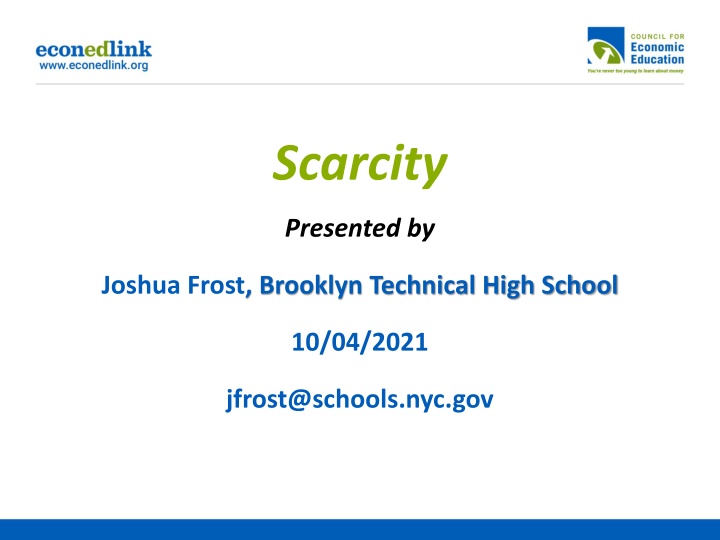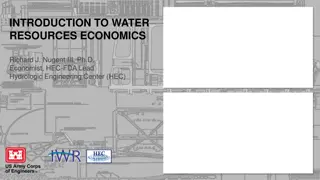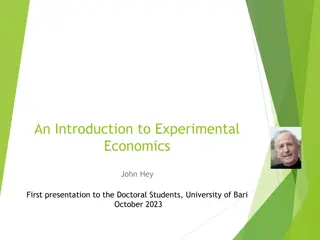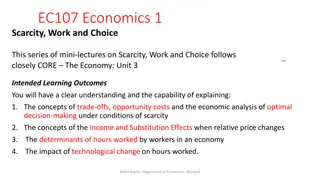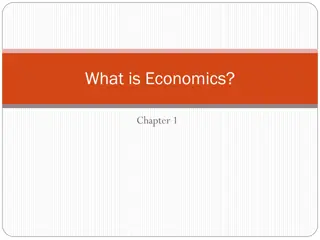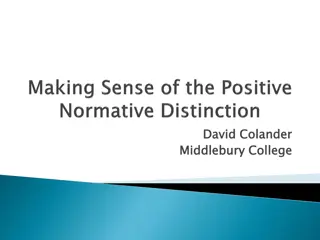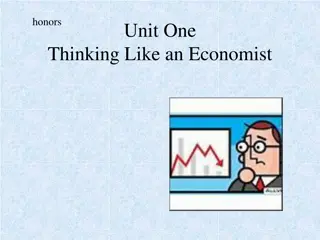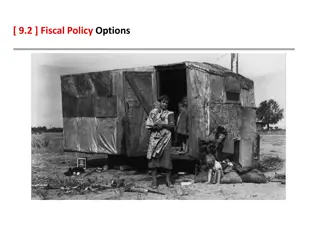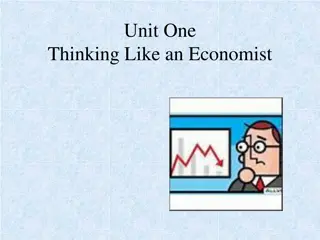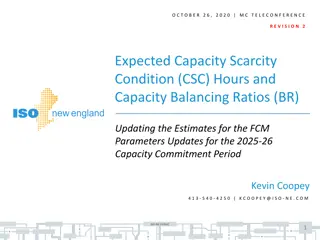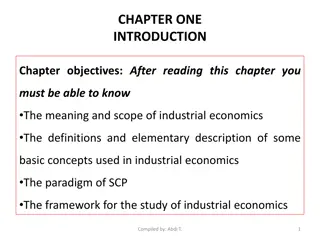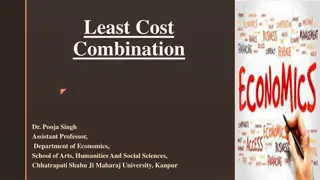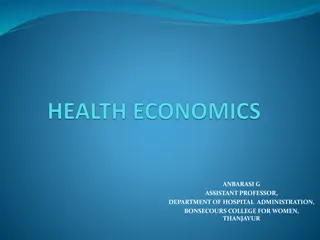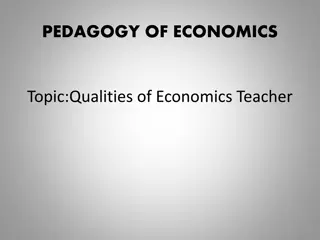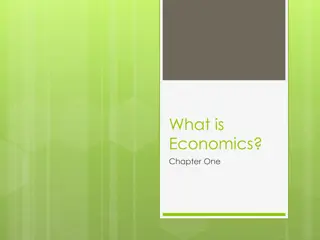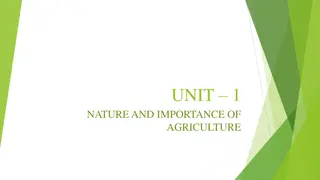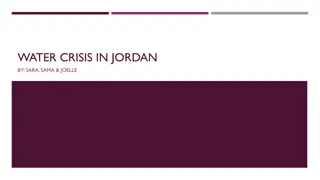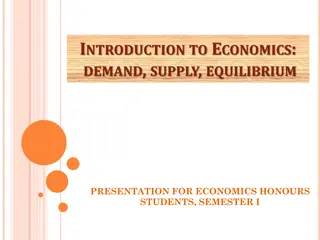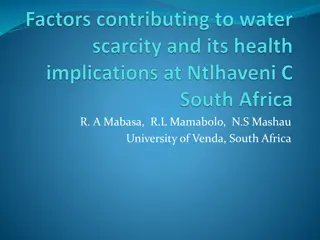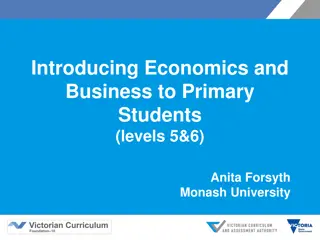Scarcity in Economics
Scarcity, a fundamental concept in economics, is presented in this resource. Explore the implications of scarcity in social, political, and economic contexts. Learn about the role of governments, market failures, and the impact on resource allocation. Discover how scarcity influences decision-making, trade-offs, and supply and demand dynamics. Delve into practical applications, classroom resources, and relevant economic principles outlined in this comprehensive guide.
Download Presentation

Please find below an Image/Link to download the presentation.
The content on the website is provided AS IS for your information and personal use only. It may not be sold, licensed, or shared on other websites without obtaining consent from the author.If you encounter any issues during the download, it is possible that the publisher has removed the file from their server.
You are allowed to download the files provided on this website for personal or commercial use, subject to the condition that they are used lawfully. All files are the property of their respective owners.
The content on the website is provided AS IS for your information and personal use only. It may not be sold, licensed, or shared on other websites without obtaining consent from the author.
E N D
Presentation Transcript
Scarcity Presented by Joshua Frost, Brooklyn Technical High School 10/04/2021 jfrost@schools.nyc.gov
EconEdLink Membership You can now access CEE s professional development webinars directly on EconEdLink.org! To receive these new professional development benefits, become an EconEdLink member. As a member, you will now be able to: Automatically receive a professional development certificate via e-mail within 24 hours after viewing any webinar for a minimum of 45 minutes Register for upcoming webinars with a simple one-click process Easily download presentations, lesson plan materials and activities for each webinar Search and view all webinars at your convenience Save webinars to your EconEdLink dashboard for easy access to the event You may access our new Professional Development page here
Professional Development Certificate To earn your professional development certificate for this webinar, you must: Watch a minimum of 45-minutes and you will automatically receive a professional development certificate via e-mail within 24 hours. Accessing resources: You can now easily download presentations, lesson plan materials, and activities for each webinar from EconEdLink.org/professional-development/
Agenda Scarcity Defined Defined Council for Economic Education Resource Overview Overview Crash Course Economics Economics Scarcity Defined as social, political, or economic issue issue Catan as classroom resource to teach Unit 1 Invisible Hand, opportunity costs, tradeoff, trade, and supply and demand Unit 1 concepts such as scarcity, PPC, Catan Extension Extension: Guns, Germs and Steel reading on the M ori and Morori
National Standards https://www.councilforeconed.org/wp-content/uploads/2012/03/voluntary-national- content-standards-2010.pdf Content Standard 16: Role of Government and Market Failure: There is an economic role for government in a market economy whenever the benefits of a government policy outweigh its costs. Governments often provide for national defense, address environmental concerns, define and protect property rights, and attempt to make markets more competitive. Most government policies also have direct or indirect effects on people s incomes. Content Standard 17: Government Failure: Costs of government policies sometimes exceed benefits. This may occur because of incentives facing voters, government officials, and government employees, because of actions by special interest groups that can impose costs on the general public, or because social goals other than economic efficiency are being pursued.
Content Standard 9: Students will understand that: Competition among sellers usually lowers costs and prices, encourages producers to produce what consumers are willing and able to buy. Competition among buyers increases prices and allocates goods and services to those people who are willing and able to pay the most for them. Content Standard 10: Institutions evolve and are created to help individuals and groups accomplish their goals. Banks, labor unions, markets, corporations, legal systems, and not-for-profit organizations are examples of important institutions. A different kind of institution, clearly defined and enforced property rights, is essential to a market economy. Content Standard 15: Investment in factories, machinery, new technology, and in the health, education, and training of people stimulates economic growth and can raise future standards of living.
State Standards NY State Standards http://www.nysed.gov/curriculum-instruction The study of economics requires an understanding of major economic concepts and systems, the principles of economic decision making, and the interdependence of economies and economic systems throughout the world. Students: analyze the effectiveness of varying ways societies, nations, and regions of the world attempt to satisfy their basic needs and wants by utilizing scarce resources define and apply basic economic concepts such as scarcity, supply/demand, opportunity costs, production, resources, money and banking, economic growth, markets, costs, competition, and world economic systems understand the nature of scarcity and how nations of the world make choices which involve economic and social costs and benefits describe the ideals, principles, structure, practices, accomplishments, and problems related to the United States economic system understand the roles in the economic system of consumers, producers, workers, investors, and voters.
Assessment Questions 1. What is a scarce resource? 2. What is scarcity? 3. How do environmental factors play a role in resource allocation? 4. Whatare opportunity costs and how do society s determine which resources are essential to their success? 5. What role does trade play in determining how to distribute and allocate scarce resources? 6. What is comparative advantage, and how do societies organize around resources and trade?
Scarcity is one of the key concepts of economics. It means that the demand for a good or service is greater than the availability of the good or service. Therefore, scarcity can limit the choices available to the consumers who ultimately make up the economy.
Scarcity Scarcity exists because we have limited resources and unlimited wants. No society has ever had enough resources to produce all the good and services its members wanted. Scarcity Scarcity requires people to make choices. If we use scarce resources for one purpose, we cannot use the for another.
Opportunity Cost Opportunity Cost is the forgone benefit of the next best alternative when resources are used for one purpose rather than another. Because of scarcity every decision has an opportunity cost. opportunity cost. scarcity Economic costs take account of the opportunity costs of doing one thing over another. opportunity costs
Activity 1.1 Activity 1.2 Visual 1.1 Available on the CEE store
Circle T for true or F for false in the statements that follow. Do You Think Like an Economist? Macroeconomics T F 3. Because water covers three-fourths of the earth s surface and is renewable, it cannot be T F 1. Because it is desirable, sunshine is scarce. T F 2. Because it is limited, polio is scarce. T F 5. If mass transportation fares are raised, almost everyone will take the trains anyway. T F 4. The main cost of going to college is tuition, room, and board. considered scarce. T F 8. If one nation produces everything better than another nation, there is no economic T F 7. If someone makes an economic gain, someone else loses. T F 6. You get what you pay for. T F 10. A business owner s decision to show more care for consumers is a decision to accept T F 9. A nonregulated monopoly tends to charge the highest possible price. reason for these two nations to trade. lower levels of profits
Scarcity Video: https://vimeo.com/331311542 Opportunity Costs: https://vimeo.com/307566929 Scarcity Kahoot Game: https://create.kahoot.it/share/scarcity-video-and-quiz/26c5b457- 7444-4594-9ff9-4514c14b1a0a
Intro to Economics: Crash Course Econ #1 - YouTube 4:25-6:45
Taxation, resource allocation, development, and economic philosophy are examples of discussion points. Global National State Local/Municipal
Representation, party affiliation, sustainability, infrastructure, interpretations of law are possible topics for discussion. Global National State Local/Municipal
Possible topics for discussion: equity, social justice, protest movements, entrenched societal systemic institutions, immigration policy Global National State Local/Municipal
by Jared Diamond https://www.amazon.com/Natural-Experiments-History- Jared-Diamond/dp/0674060199 Focus: How geography molded societies on Polynesian islands pages 53-66
Contributing to these differences among Polynesian societies were at least six sets of environmental variables among Polynesian islands: island climate, geological type, marine resources, area, terrain fragmentation, and isolation. Let's examine the ranges of these factors, before considering their specific consequences for Polynesian societies. - -Jeremy Diamond, Jeremy Diamond, Guns, Germs and Steel Guns, Germs and Steel- - page 58 page 58
CHAPTER 2: A Natural Experiment of History from Guns, Germs and Steel by Jared Diamond 1. 1. Why does Diamond call the development of Polynesian societies a natural experiment of history? 2. 2. Why did the Maori and the Moriori evolve differently? 3. 3. How does the fact that the Maori defeated the Moriori support Diamond s argument on the importance of environmental factors in history? 4. 4. What are the six environmental factors that Diamond isolates in his discussion of Polynesian societies?
5. 5. How did population density affect economies, social complexity and political organization? 6. 6. Which of the six factors do you consider most important? Explain your reasoning. 7. 7. Evaluate Diamond s arguments. Are they convincing or not? Explain where you agree or disagree with Diamond s views.
CEE Affiliates https://www.councilforeconed.org/resources/local-affiliates/
